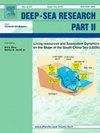New insights in benthic biodiversity of the saya de Malha Bank
IF 3
3区 地球科学
Q2 OCEANOGRAPHY
Deep-sea Research Part Ii-topical Studies in Oceanography
Pub Date : 2025-06-05
DOI:10.1016/j.dsr2.2025.105500
引用次数: 0
Abstract
In the South West Indian Ocean, a unique, remote and atypical geomorphological structure, the Saya de Malha Bank, is considered as an underwater 'island' that plays a key role in understanding benthic biodiversity and connectivity processes in the Indian Ocean. In 2022, the Saya de Malha Bank has been explored during the Indian Ocean expedition led by Monaco Explorations. A team of the Muséum national d’Histoire Naturelle (Paris) and collaborators have explored the benthic diversity of the bank by deploying a combination of sampling methods, such as towed gears (dredge, trawl, and sledge) or by scuba-diving (on-sight, brushing and suction device samplings). A total of 81 stations have been sampled, comprising 35 shallow stations on the summit of the bank (19–58 m depth) and 46 stations gaining depth on the flanks of the bank (73–1141 m depth). From these sampling events, a large collection of marine invertebrates, fish and algae has been preserved for taxonomic (morphological and molecular) studies. The inventory of the benthic biodiversity of Saya de Malha is underway, but it is a long-term process. We propose here to focus on the most represented taxonomic groups (algae, molluscs, crustaceans, annelids and fish) by compiling the primary taxonomic data for the diversity metrics and highlighting some discoveries and potential species new to science. Although the inventory is far from complete, these first results emphasize the endemicity of the fauna and flora of the Saya de Malha Bank.
对saya de Malha Bank底栖生物多样性的新认识
在西南印度洋,一个独特的、偏远的、非典型的地貌结构,Saya de Malha Bank,被认为是一个水下“岛屿”,在了解印度洋底栖生物多样性和连通性过程中起着关键作用。2022年,摩纳哥探险公司在印度洋探险期间对Saya de Malha Bank进行了勘探。法国国立自然历史博物馆(musum national d’histoire Naturelle,巴黎)的一个小组及其合作者通过采用多种采样方法,如拖网(挖泥船、拖网和雪橇)或水肺潜水(现场、刷洗和吸盘取样),探索了该银行的底栖生物多样性。共有81个站点进行了采样,其中35个站点位于河岸顶部(深度19-58米),46个站点位于河岸侧翼(深度73-1141米)。从这些采样事件中,大量的海洋无脊椎动物、鱼类和藻类被保存下来用于分类(形态和分子)研究。对Saya de Malha底栖生物多样性的调查正在进行中,但这是一个长期的过程。在此,我们建议将重点放在最具代表性的分类类群(藻类、软体动物、甲壳类、环节动物和鱼类)上,通过编制多样性指标的主要分类数据,并突出一些科学上的新发现和潜在物种。虽然清单还远未完成,但这些初步结果强调了Saya de Malha Bank的动物群和植物群的地方性。
本文章由计算机程序翻译,如有差异,请以英文原文为准。
求助全文
约1分钟内获得全文
求助全文
来源期刊
CiteScore
6.40
自引率
16.70%
发文量
115
审稿时长
3 months
期刊介绍:
Deep-Sea Research Part II: Topical Studies in Oceanography publishes topical issues from the many international and interdisciplinary projects which are undertaken in oceanography. Besides these special issues from projects, the journal publishes collections of papers presented at conferences. The special issues regularly have electronic annexes of non-text material (numerical data, images, images, video, etc.) which are published with the special issues in ScienceDirect. Deep-Sea Research Part II was split off as a separate journal devoted to topical issues in 1993. Its companion journal Deep-Sea Research Part I: Oceanographic Research Papers, publishes the regular research papers in this area.

 求助内容:
求助内容: 应助结果提醒方式:
应助结果提醒方式:


